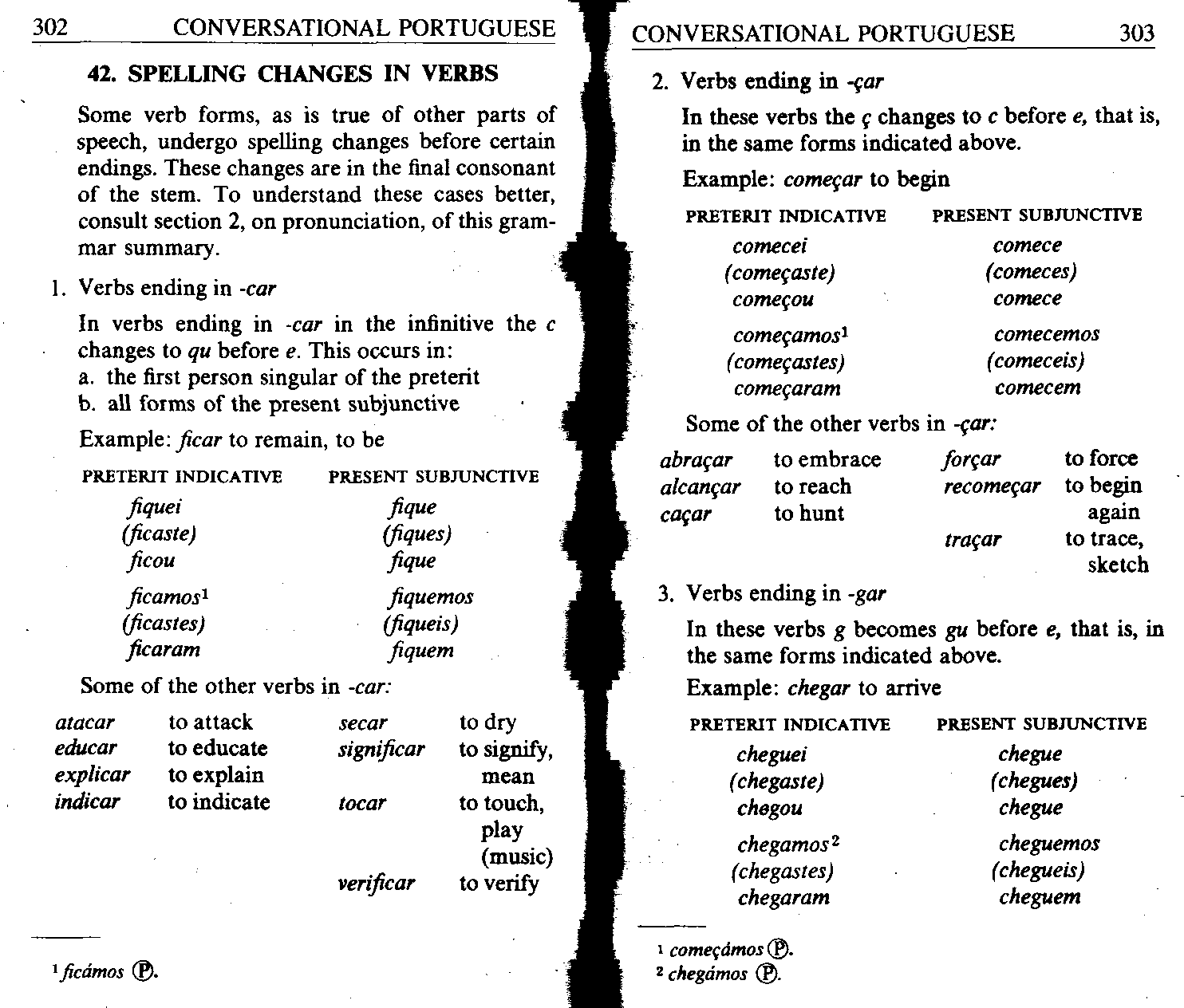Summary p302

302 CONYERSATIONAL PORTUGUESE
42. SPELLING CHANGES IN YERBS
Some verb forms, as is true of other parts of speech, undergo spelling changes before certain endings. These changes are in the finał consonant of the stem. To understand these cases better, consult section 2, on pronunciation, of this gram-mar summary.
1. Verbs ending in -car
In verbs ending in -car in the infinitive the c changes to qu before e. This occurs in:
a. the first person singular of the preterit
b. all forms of the present subjunctive
Example: ficar to remain, to be
PRETERIT INDICATIYE PRESENT SUBJUNCTIYE
|
fiąuei |
fiąue |
|
(ficaste) |
(fiąucs) |
|
ficou |
fiąue |
|
ficamos1 |
fiąuemos |
|
(ficastes) |
(fiąueis) |
|
ficaram |
fiąuem |
Some of the other verbs in -car:
|
atacar |
to attack |
sccar |
to dry |
|
educar |
to educate |
significar |
to signify, |
|
explicar |
to explain |
mean | |
|
indicar |
to indicate |
tocar verificar |
to touch, play (musie) to verify |
1ftcdmo$
2. Verbs ending in -ęar
In these verbs the ę changes to c before e, that is, in the same forms indicated above.
Example: comeęar to begin
PRETERIT INDICATIYE PRESENT SUBJUNCTIYE
comece
(comeces)
comece
comecemos
(comeceis)
comecem
Some of the other verbs in -ęar:
|
abraęar to embrace |
foręar |
to force |
|
alcanęar to reach |
recomeęar |
to begin |
|
caęar to hunt |
again | |
|
3. Yerbs ending in -gar |
traęar |
to tracę, sketch |
|
In these verbs g becomes gu before |
e, that is, in | |
|
the same forms indicated above. | ||
Example: chegar to arrive
PRETERIT INDICATIVE PRESENT SUBJUNCTIYE cheguei chegue
(chegaste) (chegues)
chegou chegue
chegamos2 cheguemos
(chegastes) (chegueis)
chegaram cheguem
comeęamos (p)-
chegamos (£).
Wyszukiwarka
Podobne podstrony:
Summary p300 300 CONYERSATIONAL PORTUGUESE cated, the change given will pertain to those forms of
Summary p236 236 CONYERSATIONAL PORTUGUESE De and em combine with the demonstrative forms (see GS2
Summary p266 266 CONYERSATIONAL PORTUGUESE27. NEGATION 1. Ndo “not” comes before
Summary p284 284 CONYERSATIONAL PORTUGUESE finał a changed to e and finał e changed to a (but also
Summary p306 306 CONYERSATIONAL PORTUGUESE 7. Verbs ending in -guer ot -guir In these verbs gu cha
Summary p222 222 CONYERSATIONAL PORTUGUESE 21. Vamos_(to have dinner). a. jantar
Summary p224 224 CONYERSATIONAL PORTUGUESE (3) variations occur in different areas: a.
Summary p226 226 CONYERSATIONAL PORTUGUESH CONYERSATIONAL PORTUGUESE 227 d g g h j I I Ut m as d i
Summary p230 230 CONYERSATIONAL PORTUGUESE 3, The cedilla (cedilha) is used with
Summary p234 234 CONYERSATIONAL PORTUGUESE k. with parts of the body and articles of clothing inst
Summary p238 238 CONYERSATIONAL PORTUGUESE 13. MASCULINE AND FEMININE 238 CONYERSATIONAL PORTUGUES
Summary p240 240 CONYERSATIONAL PORTUGUESE 14. THE PLURAL 1. Nouns ending in a vowel, including na
Summary p242 242 CONYERSATIONAL PORTUGUESE seu can also be used to translate “his,” “her,” “their.
Summary p246 246 CONYERSATIONAL PORTUGUESE 1«. COMPAR1SON 1. Rcgular comparison facil easy ma
Summary p248 248 CONYERSATIONAL PORTUGUESE 19. PRONOUNS Pronouns have varying forms depending on w
Summary p250 250 CONYERSATIONAL PORTUGUESE CONYERSATIONAL PORTUGUESE_ 251 (te) I
Summary p254 254 CONYERSATIONAL PORTUGUESE Nao me escreva mais. Eles decidiram que nos mandar
Summary p256 256 CONYERSATIONAL PORTUGUESE 21. SOME CONJUNCTIONS ainda que assim que ate
Summary p258 258 CONYERSATIONAL PORTUGUESE 23. ADYERBS 1. Some Portuguese adverbs are formed by ad
więcej podobnych podstron